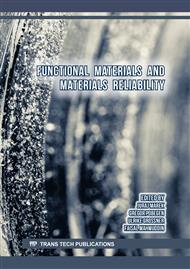p.3
p.13
p.19
p.27
p.35
p.45
p.57
p.75
Control of the Deformation Mode of Aluminum Foam-Filled Tubes as a Function of Foam Porosity
Abstract:
This paper focuses on the computational modeling of the crashworthiness performance of designed foam-filled thin-walled tubular structures under quasi-static compression loading. The studied foam sample is designed in SolidWorks using the ‘sphere subtraction method’ and implemented as a filler material in the thin-walled tube. The quasi-static compression was simulated by Abaqus software. The foam porosity is manipulated to enhance the crashworthiness performance of empty tubes. The deformation mode and energy absorption capability of the analyzed structures are introduced in detail. The numerical results showed that foam-filler material could change the deformation mode and improve stability during the compression process of thin-walled tubular structures. The number of lobes significantly increases when introducing the foam filler to the tube. These folds are affected by the foam porosity. Results also indicate that the total crushing load of the foam-filled tube is also a function of foam porosity, the mechanical response of the foam-filled tubes tended towards the response of the empty tube for a high porosity (P >85%), while for low porosity (P<85%) the mechanical response of the foam-filled tubes exhibits the three universal deformation characteristics of foams, namely, initial linear stage, extended plateau stage, and final densification stage. The main mechanical properties: collapse stress, plateau stress, and densification strain were obtained via the energy-efficient method for different configurations. The calculated mechanical properties exhibited a strong dependence on foam porosity. To give a quantitative description of the obtained quasi-static compressive properties, these properties are expressed as a function of foam porosity. The proposed formulas can easily recover the quasi-static compressive properties of the empty tube in the case of the absence of foam. The control of the compressive performance of foam-filled tubes as a function of porosity allows for finding an optimum geometry with a predefined foam porosity value adjusted for a given application.
Info:
Periodical:
Pages:
3-12
Citation:
Online since:
June 2023
Authors:
Price:
Сopyright:
© 2023 Trans Tech Publications Ltd. All Rights Reserved
Share:
Citation:


